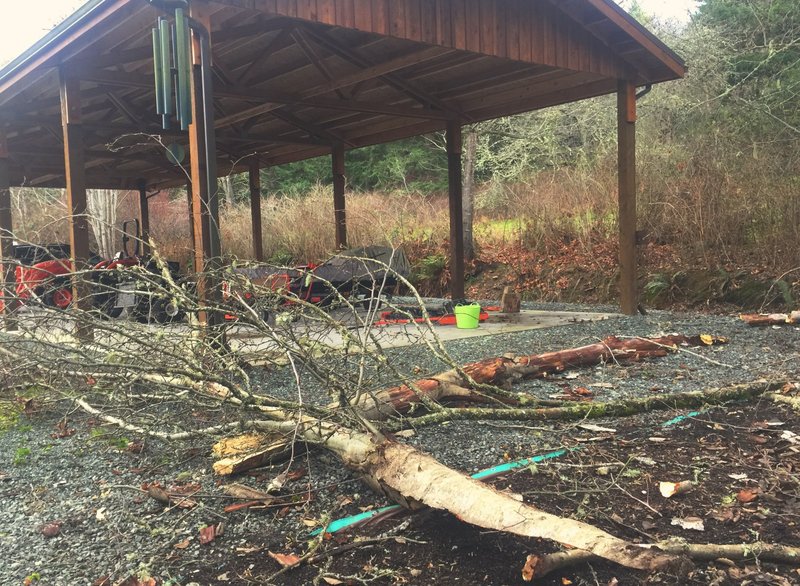
This Jan. 3, 2020 photo, shows a near miss after a windstorm broke off a large tree branch adjacent to a new machine shed near Langley, Was. (Photo: AP)
Fiercer and more frequent natural disasters in recent years have many homeowners re-evaluating their landscaping. Many are restocking with trees and plants more resilient in the face of storms, fires and flooding.
Scientists link the higher frequency of severe weather events to climate change.
There are steps home gardeners can take.
"Protect your property from wind and wildfires by checking tree and shrub species for winds and flammability before using them around the home," said Mark Tancig, a horticulturist with the University of Florida Institute of Food and Agricultural Sciences (UF/IFAS).
"Native tree species are more adaptive to diseases and insects," Tancig said. "They also tend to be more aerodynamic, making them a better bet for surviving high winds."
Avoid trees with delicate wood that breaks apart easily in severe weather. Small species that mature below the strongest wind gusts are better choices in urban and suburban landscapes than tall ones, said Theresa Badurek, another UF-IFAS horticulturist.
"Trees that grow very quickly usually have brittle wood," Badurek said. "Slow and steady wins this race."
Trees with shallow or damaged roots are prone to blow over. "Don’t cut the roots of a tree for sidewalks, driveways or patios. Work around them," she said.
People living in the Gulf and Mid-Atlantic states contend with hurricanes, while those in the West cope with wildfires. Thunderstorms, tornadoes and flooding cause most of the destruction in the nation’s interior, and then there’s the damage caused by lightning, hail, icing, mud and landslides — events that can occur almost anywhere.
"If mature trees are damaged, rotting or dying back, hire a certified arborist to prescribe preventive pruning or removal and replacement before the next big storm," Badurek said.
Lightning strikes are an unpredictable and explosive natural hazard.
"Tall trees can be damaged or killed by lightning," Badurek said. "Lightning can jump from trees into nearby homes and utilities." To help minimize losses, install lightning rods toward the top of your highest-value trees and ground the coils, Tancig said.
People facing wildfire damage should create defensible space around their homes. Close-in areas should be free of brush, debris and firewood, have irrigated sections nearby and include an abundance of fire-resistant plants.
No plant is fireproof, but many are fire-resistant. These are plants with supple leaves without waxy or resinous surfaces, said Amy Jo Detweiler, a horticulturist with Oregon State University Extension.
Proven fire-resistant plant species include daylilies, coneflowers, coreopsis, lavender and high-moisture succulents. Lilacs and hedging roses make good shrubs for wildfire country, while hardwood varieties like maples, poplar and cherry are safer choices among trees. Avoid landscaping using conifers with wood containing flammable waxes, fats or oils.
Although fire-resistant plant varieties might still be damaged or killed in wildfires, their foliage and stems don’t significantly fuel the fires’ intensity, Detweiler said.
Some other OSU Extension precautions include:
Trimming trees and shrubs and placing them about 10 feet from one another.
Using non-flammable mulch like crushed rock around houses and outbuildings.
Cleaning debris from roofs and gutters.
Removing lawns near houses or keeping them watered and mown short.


